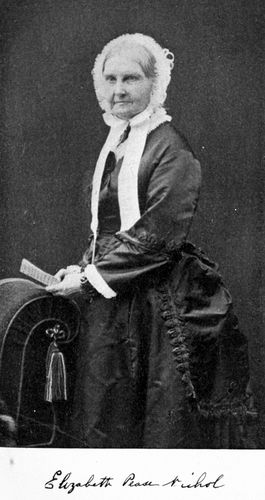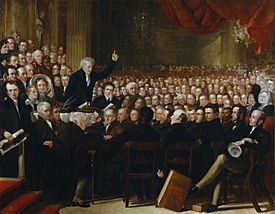Elizabeth Pease Nichol facts for kids
Quick facts for kids
Elizabeth Pease Nichol
|
|
|---|---|
 |
|
| Born |
Elizabeth Pease
5 January 1807 Darlington, England
|
| Died | 3 February 1897 (aged 90) Edinburgh, Scotland
|
| Nationality | British |
| Known for | Abolitionist and suffragist |
Elizabeth Nichol (born Elizabeth Pease; 5 January 1807 – 3 February 1897) was an important British activist in the 1800s. She worked to end slavery and fought for women's suffrage (the right for women to vote). Elizabeth also supported the Chartist movement, which pushed for more rights for working-class people.
She was active in groups like the Peace Society and the Temperance movement, which aimed to reduce alcohol use. Elizabeth also started the Darlington Ladies Anti-Slavery Society. In 1853, she married Dr. John Pringle Nichol, a professor of astronomy. She was one of the few women shown in a famous painting of the 1840 World Anti-Slavery Convention.
Contents
Biography
Elizabeth's Early Life and Education
Elizabeth Pease was born in Darlington, England, on January 5, 1807. Her parents, Joseph Pease and Elizabeth Beaumont, were members of the Religious Society of Friends (Quakers). Quakers are a Christian group known for their peaceful beliefs. Elizabeth's father also helped start the Peace Society.
Quakers believed that girls should get a good education, just like boys. Elizabeth went to school with her brother and male cousins. She was one of only two girls there. When that school closed, she continued her studies at home. Elizabeth also helped care for her mother, who was often ill.
Starting Public Activism
By 1837, Elizabeth Pease was a leader in the Darlington Ladies Anti-Slavery Society. This group worked to end slavery. Charles Stuart, an anti-slavery speaker, encouraged her to get more involved nationally. He wanted her to send a female representative to a new national society.
Elizabeth preferred to work locally, even though she was asked to do more. She did not want to be in the spotlight. However, she still wanted to make a big difference for the causes she believed in.
In 1838, Elizabeth wrote an important pamphlet with Jane Smeal. It was called Address to the Women of Great Britain. This document asked British women to speak out in public. It also encouraged them to form their own anti-slavery groups.
The 1840 Anti-Slavery Convention
In 1840, Elizabeth Pease traveled to London for the World Anti-Slavery Convention. It started on June 12. Her friend, Eliza Wigham, also attended. Before the convention, Elizabeth met American activists Lucretia Mott and Elizabeth Cady Stanton.
However, the British organizer, Joseph Sturge, told the six women delegates they could not participate. Some English anti-slavery leaders did not want women to be involved. They called it an "insane innovation." Women attendees were made to sit in separate areas. These areas were out of sight of the male delegates.
This rule caused a big argument. Some male delegates from the United States supported the women. They included George Bradburn and Wendell Phillips. William Lloyd Garrison refused to take his seat until women were treated equally. In the end, the American women had to sit with British women observers. These observers included Lady Byron and Anne Knight.
The painting above shows Elizabeth Pease at this international event. Delegates came from many countries, including the United States and France. Most women in the painting are shown on the far right. Elizabeth Pease and Anne Knight were among the notable women chosen for the painting. Other women included Amelia Opie and Lucretia Mott.
Fighting for Women's Right to Vote
After moving to Edinburgh, Elizabeth became the treasurer for a women's suffrage group. This group was the Edinburgh chapter of the National Society for Women's Suffrage. It worked to gain voting rights for women.
Eliza Wigham and Jane Wigham helped set up this Edinburgh chapter. Eliza and her friend Agnes McLaren were the secretaries. Priscilla Bright McLaren was the president of the group.
Marriage and Family Life
In 1853, Elizabeth married Dr. John Pringle Nichol. He was a professor of astronomy at the University of Glasgow. She then moved to Glasgow to live with him. Her family did not approve of the marriage. This was because Nichol was a Presbyterian, not a Quaker.
Quaker rules at the time meant that Elizabeth had to leave the Society of Friends. This was because she married someone outside their faith. After her husband died, she moved to Edinburgh. She lived at Huntly Lodge in the Merchiston area.
Elizabeth Nichol is buried with her husband in Grange Cemetery in Edinburgh.
Lasting Recognition
In 2015, local historians in Edinburgh started a campaign. They wanted to recognize four women connected to the city. These women were Elizabeth Pease Nichol, Priscilla Bright McLaren, Eliza Wigham, and Jane Smeal. The historians called them the city's "forgotten heroines."
See also
 In Spanish: Elizabeth Pease Nichol para niños
In Spanish: Elizabeth Pease Nichol para niños



